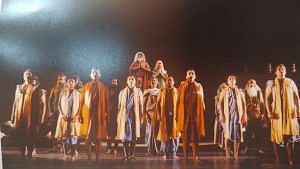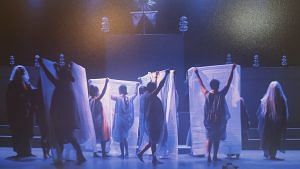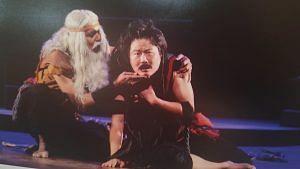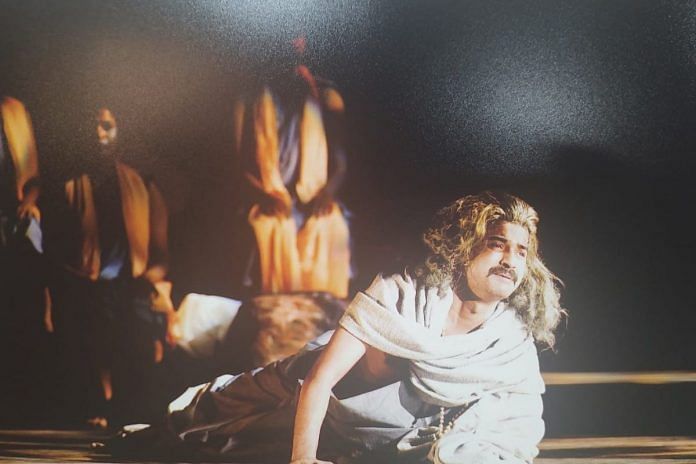Andha Yug, an iconic 1953 play about the Mahabharata and its relentless violence, returned to a packed auditorium at the National School of Drama after a three-decade hiatus. As many in the audience tried to dissect its relevance today, the director, Ram Gopal Bajaj, As many in the audience scrambled to find its relevance today, the director, Ram Gopal Bajaj, said it was open to interpretation.
Penned by playwright Dharamvir Bharati, Andha Yug, which translates as Blind/Dark age, is set on the last day of the 18-day Mahabharata and looks at the war through the perspective of secondary characters like Ashwatthama, Gandhari, and Yuyutsu. The play, made with a generous budget of Rs 18 lakh and released on World Theatre Day on 27 March, moves from chaos to order, posing questions about accountability and morality in the epic battle that, even toward its conclusion, spawned irreversible damage to the fundamentals of humanity.
In the overarching theme of good versus evil, the Mahabharata’s landscape is permeated with excessive violence and crime, including murder, infanticide, molestation, and discrimination based on caste and gender. But apart from this not-so-easy-to-digest bloodbath, it also advocates for non-violence and glorifies the path of righteousness.

This cause-and-effect of violence spills into all we see around us, and is exactly what Andha Yug dissects. In a scene where Sanjay–blessed with divya drishti (divine vision) that allowed him to view the war sitting miles away–narrates the horrific details of the battle to Gandhari, the latter breaks down in anguish. Bajaj conveys the agony of this situation without presenting the gruesome violence on stage, and the audience is quick to show its appreciation. A feeble cheer at one corner gradually transforms into a deafening applause as the scene ends.
“The discourse around the play and its staging should have ended by now. But it is unfortunate that even today, this play resonates with society at large. It is a humanitarian crisis. Until that ends, Andha Yug will prevail,” said Bajaj during a press conference before the show’s premiere at NSD’s Abhimanch Auditorium.
Bharati, a man of many talents, is known to be one of the pioneers of the Hindi literary world. Before his death in 1997, he had created an indomitable body of work, with influences from the Mahabharata and the works of Karl Marx, Albert Camus, Jean-Paul Sartre, Kabir, and Surdas.
Written shortly after the Partition, Andha Yug used the Mahabharata as an allegory to reflect on the politics of violence endured by newly-independent India. Much like the Kurukshetra war, freedom came at the cost of carnage, trauma, and irrevocable scarring—and the play uses key instances from the Mahabharata to drive these points home. The audience cheers as Gandhari curses Krishna, Ashwatthama grapples with foul play, and Yuyutsu, one of the Kauravas, is torn between siding with his brothers and the path of righteousness.

Also read:
One story, many storytellers
Considered to be a contemporary Indian classic, the stimulating play has been interpreted by several theatre directors as anti-war.
It was first performed in 1963, directed by Ibrahim Alkazi, in Delhi’s Feroz Shah Kotla Stadium, now known as Arun Jaitley Stadium. Then-Prime Minister Jawaharlal Nehru also attended the play. It further gained momentum in the ’60s and ’70s, staged under the direction of theatre greats such as Girish Karnad and MK Raina. While it returned to the stage once in 2011, organised by Sahitya Kala Parishad in Delhi, it remained absent from the National School of Drama for 30 years, with the last staging being conducted in 1992.
Bajaj, who has also served as NSD’s director and is a Padma Shri awardee, acted in one of the earliest stagings of the play as a second-year student at the institution in 1964 before going on to direct his magnum opus in 2023.
Also read:
Performances lure young audience
Ramparts are in ruins, the city is burning, and Kurukshetra, the focal point of the war, is covered with corpses and raptors. As the majority of the Kaurava army is slaughtered, the remaining ones seethe with rage and grief. After Duryodhana, the primary antagonist in the epic, is killed, the task to avenge his death and teach Pandavas a lesson falls onto Ashwatthama’s shoulders.
Bikram Lepcha, who plays Ashwatthama, gestures to release Brahmastra, a weapon known to cause destruction. Thumping music, by Ajay Kumar, Santosh Kumar Singh, and Rajesh Singh, magnifies the impact of Ashwatthama’s dangerous move.

After the weapon lands on pregnant Uttara’s womb, it ends up extinguishing the future of Pandavas’ lineage. A loud voice fills the 300-seater auditorium. Krishna, who is physically absent from the stage, curses Ashwatthama for his actions. A thunderous applause follows, lauding Lepcha’s impressive acting.
Four artists seated on both ends of the stage help with the transition between the scenes with their soulful songs.
In the next scene, just as Gandhari receives the news about Ashwatthama’s demise and the Kauravas’ consequent defeat, she curses Krishna for being the benefactor of the war. The voice returns and accepts the curse with utmost humility. Potshangbam Rita Devi’s performance receives roaring applause and a standing ovation from the audience.
In the end, Krishna dies at the hands of a common ascetic, indicating the end of Dwapara Yuga, and the beginning of Kali Yuga.
But it is the performances that lured the young people into the audience.
Radha and Ishita, second-year students of Delhi University and theatre enthusiasts, dissect the aspects of Lepcha’s performance as they walk to the nearby Mandi House metro station, armed with the play’s brochure.
“I didn’t know much about the play besides the fact it is a classic literary piece. But when I got to know that Bajaj sir is going to direct it, we had to come,” says Ishita, as Radha smiles in agreement.
(Edited by Zoya Bhatti)



